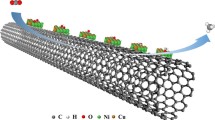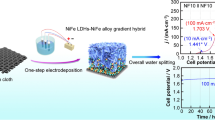Abstract
Homogeneous Ni x Cu1 − x and Ni x Co1 − x (x = 0.90–0.99) alloys have been prepared through the coprecipitation of precursors (hydroxides or carbonates) and reduction of the precipitate. The formation of single-phase Ni x M1 − x alloys in all of the samples has been confirmed by X-ray diffraction. We have assessed the catalytic activity of the alloys for 1,2-dichloroethane decomposition with carbon nanomaterial (CNM) formation. The highest catalytic activity (CNM yield, 26–27 g/gcat) was offered by the nickel alloys containing ∼1 at % Cu or Co. The carbon material obtained has the form of segmented submicron wires with high morphological uniformity.
Similar content being viewed by others
References
Kartashov, L.M., Treger, Yu.A., Flid, M.R., et al., Exhaustive catalytic hydrodechlorination, Catal. Ind., 2009, vol. 1, no. 3, pp. 201–206.
Lokteva, E.S., Kachevskii, S.A., Turakulova, A.O., et al., The hydrodechlorination of chlorobenzene in the vapor phase in the presence of metal-carbon nanocomposites based on nickel, palladium, and iron, Russ. J. Phys. Chem. A, 2009, vol. 83, no. 8, pp. 1300–1306.
Chary, K.V.R., Rao, P.V.R., and Vishwanathan, V., Synthesis and high performance of ceria supported nickel catalysts for hydrodechlorination reaction, Catal. Commun., 2006, no. 7, pp. 974–978.
Srębowata, A., Juszczyk, W., Kaszkur, Z., et al., Hydrodechlorination of 1,2-dichloroethane and dichlorodifluoromethane over Ni/C catalysts: the effect of catalyst carbiding, Appl. Catal., A, 2007, no. 319, pp. 181–192.
Morato, A., Alonso, C., Medina, F., et al., Conversion under hydrogen of dichlorodifluoromethane and chlorodifluoromethane over nickel catalysts, Appl. Catal., B, 1999, no. 23, pp. 175–185.
Chesnokov, V.V., Buyanov, R.A., and Pakhomov, N.A., RF Patent 2 093 228, 1997.
Chesnokov, V.V. and Buyanov, R.A., Formation of carbon wires during catalytic decomposition of hydrocarbons on iron-group metals and their alloys, Usp. Khim., 2000, vol. 69, no. 7, pp. 675–692.
Mishakov, I.V., Buyanov, R.A., Zaikovskii, V.I., et al., Catalytic synthesis of nanosized feathery carbon structures via the carbide cycle mechanism, Kinet. Catal., 2008, vol. 49, no. 6, pp. 868–872.
Bauman, Yu.I., Mishakov, I.V., Buyanov, R.A., et al., Catalytic properties of massive iron-subgroup metals in dichloroethane decomposition into carbon products, Kinet. Catal., 2011, vol. 52, no. 4, pp. 547–554.
Mishakov, I.V., Bauman, Y.I., Korneev, D.V., and Vedyagin, A., A metal dusting as a route to produce active catalyst for processing chlorinated hydrocarbons into carbon nanomaterials, Top. Catal., 2013, vol. 56, no. 11, pp. 1026–1032.
Bauman, Yu.I., Mishakov, I.V., Vedyagin, A.A., et al., Processing of organochlorine waste components on bulk metal catalysts, Catal. Ind., 2012, vol. 4, no. 4, pp. 261–266.
Karyakin, Yu.V. and Angelov, I.I., Chistye khimicheskie veshchestva (Pure Chemical Substances), Moscow: Khimiya, 1974, p. 408.
Powder Diffraction File, PDF-2/Release 2009, International Centre for Diffraction Data, 2009.
Cullity, B.D., Elements of X-ray Diffraction, Reading: Addison-Wesley, 1978.
Oezaslan, M., Hasche, F., and Strasser, P., In situ observation of bimetallic alloy nanoparticle formation and growth using high-temperature XRD, Chem. Mater., 2011, no. 23, pp. 2159–2165.
Krumm, S., An interactive Windows program for profile fitting and size/strain analysis, Mater. Sci. Forum, 1996, vols. 228–231, pp. 183–190.
Mishakov, I.V., Chesnokov, V.V., Buyanov, R.A., and Pakhomov, N.A., Decomposition of chlorinated hydrocarbons on iron-group metals, Kinet. Catal., 2001, vol. 42, no. 4, pp. 543–548.
The Pauling File Inorganic Materials Database and Design System—Binaries Edition, ASM International, 2002.
Author information
Authors and Affiliations
Corresponding author
Additional information
Original Russian Text © A.V. Rudnev, A.S. Lysakova, P.E. Plyusnin, Yu.I. Bauman, Yu.V. Shubin, I.V. Mishakov, A.A. Vedyagin, R.A. Buyanov, 2014, published in Neorganicheskie Materialy, 2014, Vol. 50, No. 6, pp. 613–619.
Rights and permissions
About this article
Cite this article
Rudnev, A.V., Lysakova, A.S., Plyusnin, P.E. et al. Ni-Cu and Ni-Co alloys: Synthesis, structure, and catalytic activity for the decomposition of chlorinated hydrocarbons. Inorg Mater 50, 566–571 (2014). https://doi.org/10.1134/S0020168514060156
Received:
Accepted:
Published:
Issue Date:
DOI: https://doi.org/10.1134/S0020168514060156




